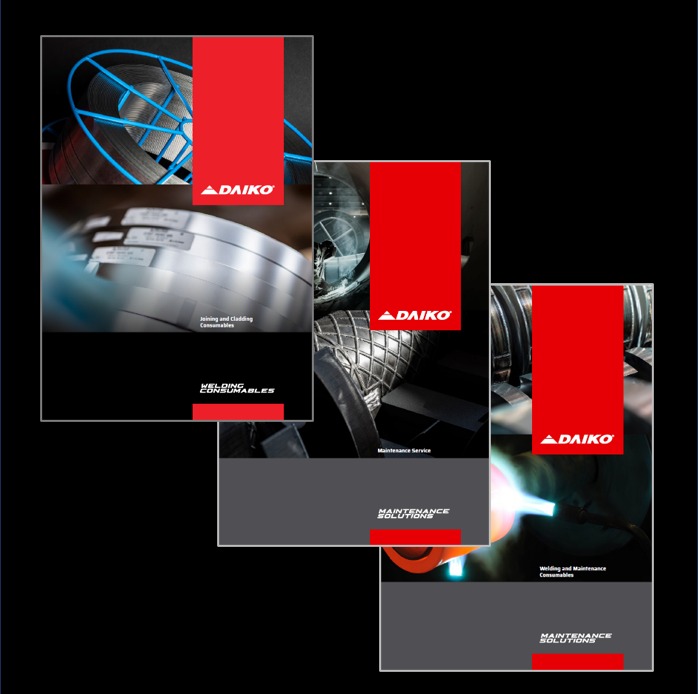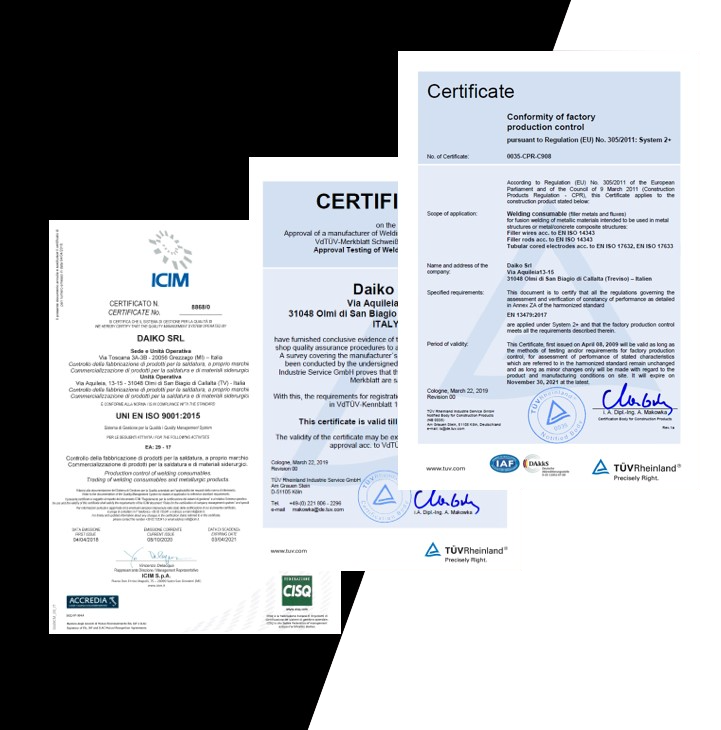- Home
- >
- All DAIKO products
- >
- CAST IRON
- >
- NiFe-CI
NiFe-CI
Application
The NiFe alloy is well-suited for welding various grades of cast iron, with a particular emphasis on spheroidal graphite (SG), nodular, or ductile irons, as well as some alloy cast irons. This alloy offers a harmonious balance of strength, ductility, and toughness, complemented by favorable machinability. Additionally, NiFe consumables can be applied to high-alloy austenitic irons (Ni-Resist). When welding flake graphite grades, a preheat of 300-350°C is recommended, while SG grades benefit from low heat input and low-temperature techniques to mitigate the risk of heat-affected zone (HAZ) hot cracking. It is crucial to note that martensitic Ni-Hard cast irons and white irons are generally considered unweldable due to their heightened crack sensitivity. Furthermore, NiFe consumables prove effective in welding transition joints between cast iron and cast steels, as well as cast iron and mild/low alloy steels. Common components addressed by this welding process include machine bases, pump bodies, engine blocks, gears, and transmission housings.
Alloy Type
Nominally Fe-55% Ni alloy for the repair and
joining of cast iron.
Microstructure
The structure
depends on the chemical composition and the
speed of solidification and subsequent
cooling down.
Materials
The NiFe weld metals produce higher strength than
the pure nickel cast iron types and are therefore
preferable for dissimilar joints, higher strength cast irons and spheroidal graphite cast irons.
EN W.Nr.: 1563:2018 Spheroidal graphite cast irons, 1562:2019-06 Malleable cast irons.
ASTM: A602, A47, A338, A220.
EN W.Nr.: 1563:2018 Spheroidal graphite cast irons, 1562:2019-06 Malleable cast irons.
ASTM: A602, A47, A338, A220.
Welding & PWHT
Welding procedures are commonly executed without preheat, but situations involving heavy multipass deposits or highly restrained joints may necessitate preheat in the range of 150-250°C. Prior to initiating the welding process, meticulous preparation of surfaces is crucial, involving careful gouging and/or grinding with limited heat application to prevent crack propagation. The designated welding area should be diligently cleaned, removing contaminants such as sand, oil, grease, paint, or rust to the greatest extent possible. Preheating becomes particularly beneficial for eliminating impregnated oil on used castings undergoing repairs. In instances where welding is conducted without preheat, it is advisable to minimize the width of the Heat-Affected Zone (HAZ) by employing a low heat input and maintaining a low interpass temperature. The application of a skip welding technique can prove advantageous in achieving this objective. For welds involving thicker sections or highly restrained conditions, preheating within the range of 150-250°C may become imperative. Light peening, aimed at reducing contraction stresses, can offer additional benefits, although caution is warranted to prevent the depletion of weld metal ductility. In certain scenarios, buttering the joint faces or the sides of the repair cavity before the filling process can be a desirable practice, regardless of whether preheat is applied. Upon completion of the welding process, it is recommended to allow the workpiece to cool gradually, with the option of insulation if deemed necessary for optimal results.
Products of the line NiFe-CI
| Product name | Process | AWS specifications | EN ISO specifications | |
| DAIKOFCW 321 | FCAW | - | - | |
| DAIKOFCW 323S | FCAW |
AWS A5.9
E NiFe-C1 |
- | |
| DAIKOWM 55 | GMAW |
AWS A5.15
ERNiFe-Cl |
EN ISO 1071
S NiFe-1 |
|
| DAIKOWT 55 | GTAW |
AWS A5.15
ERNiFe-Cl |
EN ISO 1071
S NiFe-1 |
|
| DAIKOWT 323S | GTAW |
AWS A5.15
ENiFe-Cl |
- | |
| DAIKOFCW 345 | FCAW | - |
EN ISO 1071
T C NiFe T3-Cl M21 |
|
| DAIKOWT 323 | GTAW |
AWS A5.15
ERNiFe-Cl |
- | |
| G-TECH 323 | SMAW |
AWS A5.15
ENiFe-Cl |
EN ISO 1071
E C NiFe-Cl 1 |
|
| G-TECH 323S | SMAW |
AWS A5.15
ENiFe-Cl |
EN ISO 1071
E C NiFe-Cl 1 |
|
| G-TECH 55 | SMAW |
AWS A5.15
ENiFe-Cl |
EN ISO 1071
E C NiFe-Cl |
|
| DAIKOWM 323S | GMAW |
AWS A5.15
ENiFe-Cl |
- | |
| DAIKOWM 323 | GMAW |
AWS A5.15
ERNiFe-Cl |
- |


